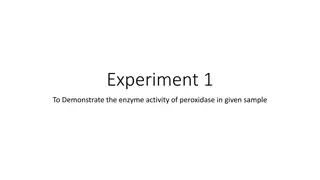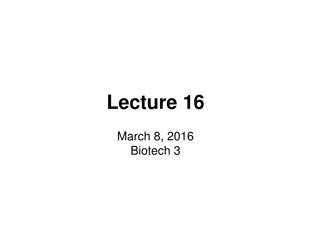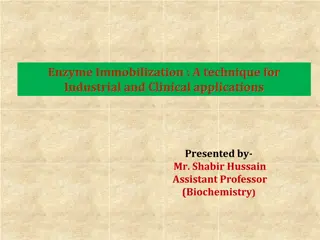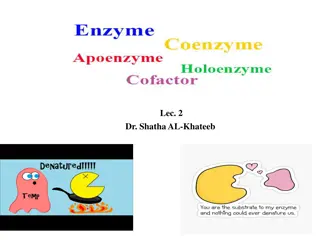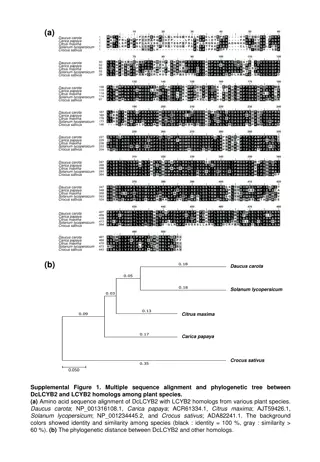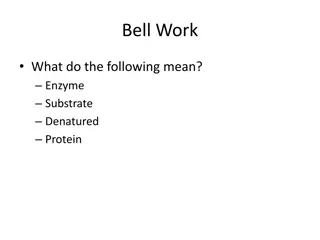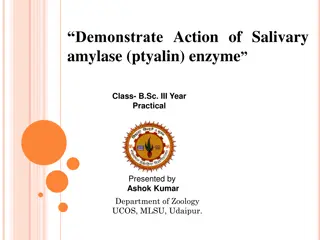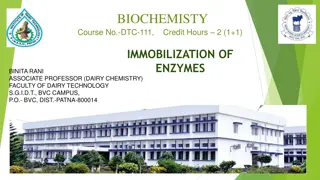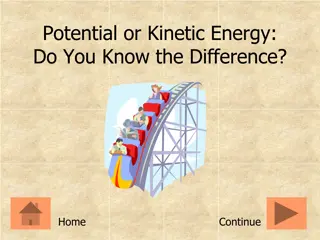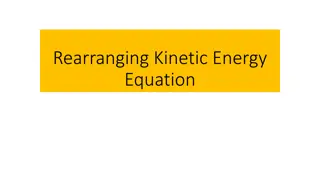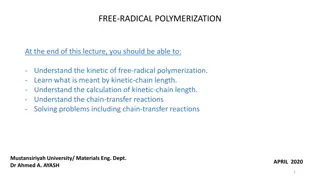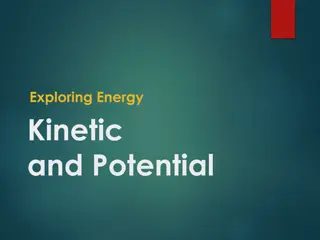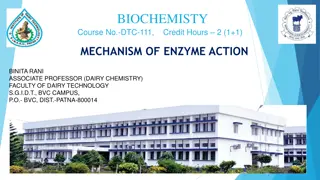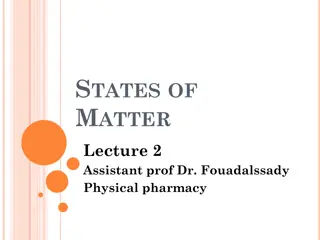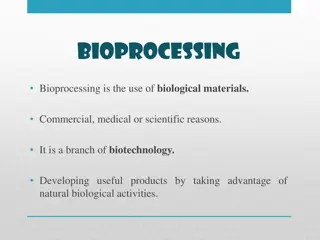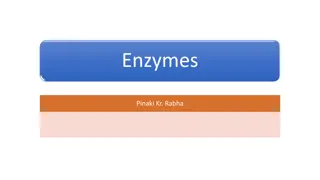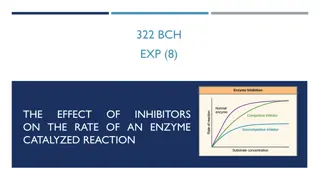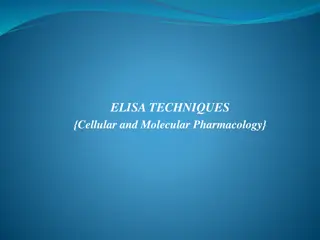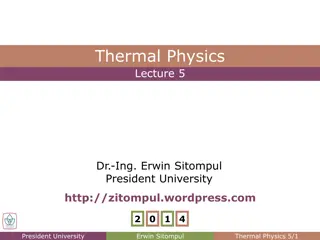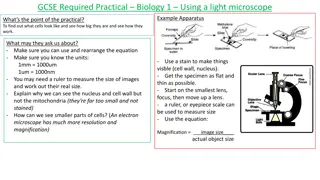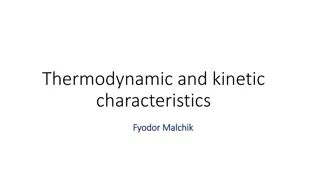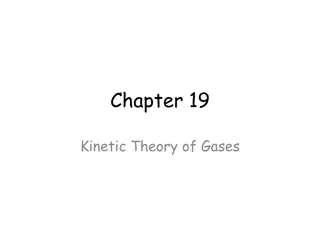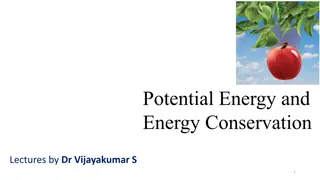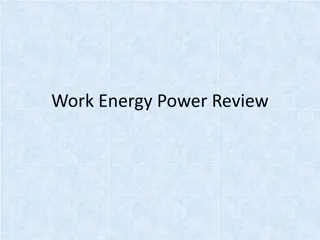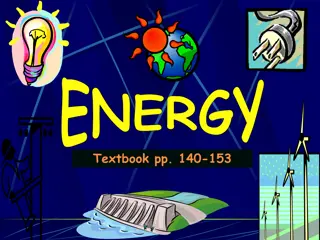Understanding Multisubstrate Enzyme Kinetic Mechanisms
In multisubstrate enzyme kinetic mechanisms, the apparent Km and Vmax values change with varying substrate concentrations. Different kinetic mechanisms like rapid equilibrium Bi Bi and ordered Bi Bi reactions can occur. The ping-pong Bi Bi reaction involves oscillation between enzyme forms. Various forces like electrostatic bonds and hydrogen bonds play crucial roles in enzyme catalysis.
Download Presentation

Please find below an Image/Link to download the presentation.
The content on the website is provided AS IS for your information and personal use only. It may not be sold, licensed, or shared on other websites without obtaining consent from the author. Download presentation by click this link. If you encounter any issues during the download, it is possible that the publisher has removed the file from their server.
E N D
Presentation Transcript
MULTISUBSTRATE ENZYME AND KINETIC MECHANISM In multisubstrate enzyme kinetic mechanism, the km for a particular substrate at one fixed set of co- substrate concentration may not be the real Km but instead an apparent value that changes as the co- substrate concentration varies. Similarly, the observed Vmaxat a saturating concentration of one substrate may not be the same Vmaxobserved when another substrate is saturating. The true Kmfor a particular substrate is the one that is observed when all other are present at saturating concentration. Multisubstrate enzyme system may proceed by a number of kinetic mechanisms namely: Rapid Equilibrium Random Bi Bi : In these case, two (2) substrate A and B might add randomly to the enzyme exactly as substrate S and inhibitor I does in classical non-competitive inhibition system and the product P and Q might leave randomly; thus E + A EA + B EB + A EAB
Substrate A binds to free enzyme with a dissociation constant Ka while B binds to free enzyme with dissociation constant Kb. The binding of one substrate may alter the affinity of the enzyme for the other. Thus, A binds to EB with dissociation constant Ka , conversely the binding of EA to B gives Kb . The only different between the rapid equilibrium BiBi reacting system and non competitive inhibitor is that EAB is catalytically active while ESI is not. If the rate limiting step is the slow conversion of EAB to EPQ, we can derive the velocity equation for the forward reaction in the absence of P and q in usual manner i.e V = Kp[EAB] and v = kp [EAB] [E] [E]+[EA]+[EB]+[EAB] If we express the concentration of each enzyme species in term of free E, we will obtain : V = [A][B] Vmax K Kb 1+ [A] + [B]+[A][B] Ka Kb KaKb Where Vmax = Kp[E] ORDERED Bi Bi REACTION: In this case, it may be impossible for B to bind until A binds and promote a conformational changes in the enzyme such that exposes the binding site. The reaction sequence is represented thus
If the conversion of EAB to EPQ is the rate limiting step, such that E, A, EA, EAB are at equilibrium, the velocity equation will give PING PONG Bi Bi REACTION: This is a mechanism of an enzymatic reaction in which two substrate and two products participate. The enzyme shuttles backward and front between its original and its modified form. According to this mechanism, after the binding of the first substrate by the enzyme, a product is released and the enzyme is converted to a modified form. The second substrate then binds to the modified form of the enzyme. This is followed by the release of the second products and regeneration of the original form of the enzyme .It is called ping-pong because the enzyme oscillates between two stable forms and could be represented as shown below: Where f is the modified form of the enzyme. Typical of these is the transfer of phosphate from mgATP to the enzyme, followed by decrease of mgATP before the glucose binds and pick up the phosphate.
A= mgATP B= GLUCOSE EA= ENZ-mgATP FP= ENZ-PO4-MGADP EQ= ENZ-GLU-6-PO4 P= mgADP E= HEXOKINASE/GLUCOKINASE FB=ENZ-PO4glucose Q= GLU-6-PO4 CHEMISTRY OF ENZYME CATALYSIS The folding of macromolecules, binding of substrate to enzyme, the interactions of cells and in fact all molecular interactions in biological systems require the interplay of at least four (4) different kind of forces or interactions namely: Electrostatic bond/ interaction Hydrogen bond Vander Waals force Hydrogen bonding These four fundamental non covalent bonds differ in their geometric requirement, strength and specificity. More so, they are affected in different ways by the presence of water molecules. ELECTROSTATIC INTERACTION: A charged group on a substance can interact with oppositely charged group on an enzyme and the force of such electrostatic interaction is given by coulombs law, which states that: F = q1q2 wherein q1q2are the charges of the 2 groups r D r = distance between them D = dielectric constant of the medium
Note that electrostatic interaction is strongest in a vaccum (where D=1) and weakest in medium such as (where D=80). A typical example is the binding of glycyl-l-tyrosine carboxypeptidase A, a proteolytic enzyme that cleaves carboxyl terminal residue. In this case, the negatively charged terminal carboxyl group of the dipeptide substrate interacts with the positively charged guanidinium group of a arginine residue. This type of interaction is also called ionic bond, salt bridge or salt linkage or ion pair. Also, the imidazole group of histidine and positively charged group of lysine are also potential binding site for negatively substrate. HYDROGEN BONDING: Many substrates are uncharged, yet they bind to enzyme with affinity and specificity. The significant interactions for this substrate and indeed for most charged substrate are H-bonding. The atom to which hydrogen is more tightly linked is called hydrogen donor whereas the atom is the hydrogen acceptor. The acceptor has a partial negatively charge that attracts the hydrogen atom. For instance,
Meaning that the donor atom in H-bonding in biological system could be oxygen or nitrogen atom that has a covalently attached hydrogen atom while the acceptor is either oxygen or nitrogen. The strongest bond occur in a situation whereby the donor, hydrogen and acceptor atom are co-linear. If the acceptor is at an angle to the line joining the donor atom and hydrogen atom, the bond becomes weaker with increasing angle. The role of hydrogen bonding interaction of substrate with enzyme could be illustrated by the binding of the uridine of the substrate to pancreatic ribonuclease ( an enzyme that cleaves ribonucleic acid). Three hydrogen bonding capacity are involved The hydrogen bond capacity of lysine, aspartate , glutamine, tyrosine, histidine, varies with pH, thus they can serve as both hydrogen bond donor or acceptor over a certain range of Ph. VANDER WAALS INTERACTIONS: This is weaker and less specific (but not less important in biological system) than electrostatic and hydrogen bonds. The basis of VanderWaals interaction is that the distribution of an electrostatic charge around an atom charges with time and at any instant, the charge distribution is not perfectly symmetric. Thus, thin transient asymmetric in the electronic charge will alter the electronic distribution around its neighboring atom. The attraction between a pair of atom increases as they come closer until they are separated by Vander Waals constant distance. At a shorter, distance, very strong repulsive forces become dominant because the outer electron cloud overlaps.
HYDROPHOBIC INTERACTION: It is another major driving force in the folding of macromolecules and it exist when substrate bind to an enzyme or when other macromolecules interact in biological system. It is more prominent when non-polar molecule or group cluster together in an aqueous medium. The presence of water diminishes the strength of electrostatic and hydrogen bonding capacity between molecules or ionic concern. However, the binding of substrate to the active site of an enzyme tends to exclude water from it thereby strengthen the interaction between the enzyme and the substrate . MECHANISM OF ENZYME ACTION In this section, we would consider the mechanism of carboxypeptidase A, lysozyme, and chymotrypsin. CARBOXYPEPTIDASE A : This is a proteolytic enzyme that hydrolyses the carboxyl terminal peptide bond in polypeptide hydrolysis occur most readily if the carboxyl terminal residue has an aromatic or bulky aliphatic side chain. Carboxypeptidase A is a single polypeptide chain of 307 amino acids residues. It has a compact shape containing region of -helix of about 28% and a beta-helical portion of about 17% (beta-pleated sheet). It has a tightly bond zinc ion which is essential for enzymatic activity. The zinc ion is located in a groove near the surface of the molecule where it is co-ordinate to the tetrahedral side chain and a water molecule. There is always a large pocket where the zinc ion accommodated the side chain of the terminal residue of the peptide substrate. The mechanism of action of this enzyme involves 2 aspects: Induced fit Electronic strain The binding of substrate e.g glycyl-tyrosine induces large structural changes at the active site of carboxylpeptidase A such that its binding to the active site could be described on the basis of 5 interactions : The positively charged terminal carboxylase of glycyl-tyrosyine interact electrostatically with the positively charge side chain of Arg 145. The tyrosine side chain of the substrate tends to binds with the non polar or pocket region of the enzyme. The NH hydrogen of the peptide bond to be cleaved id hydrogen bonded to the hydroxyl group of the aromatic side chain of tyrosine-248. The carboxyl-oxygen of the peptide bond to be cleaved is co-ordinated to the zinc ion. The terminal amino acid of substrate is hydrogen bonded through, thus the mechanism of catalytic action of this enzyme as based on x-ray crystallographic study is explained thus
In this mechanism, the OH group on tyr 248 donates a proton to the NH of the peptide bond to be cleaved, the c=o carbon atom of this peptide is attacked by the carboxylate group of glu-270. The resulting anhydride of glu-270 and the acid component of the substrate is hydrolysed in the subsequent step. The role of zinc is this catalytic scheme is to render the carbonyl atom more vulnerable to nucleophilic attack, thus, it does by pointing towards the susceptible carbonyl group, thus inducing a dipole which may be further enhanced by the non-polar end of the zinc ion. The proximity of the negatively charge on glu-270 also contribute to the induction of a large dipole in the c=o group, thus carboxypeptidase A induces electronic strain in its substrate to accelerate catalysis. MECHANISM OF ACTION OF LYSOZYME Lysozyme is often refered to as bacteriolytic enzyme i.e an enzyme that lyse or dissolves bacteria by cleaving the polysaccharide that occur in the glycopeptides component or layer of their cell wall. It is a relatively small enzyme made up of a single polypeptide chain of 129 amino acid. It has a mass of approximately 14.6kDalton. the enzyme is cross-linked by 4 disulfide bridges which are between the cysteine residue at positions 6&127, 30&115, 64&80, and 76&94. Hydrophobic interactions plays an important role in the folding of lysozyme , although the interior of the enzymeis almost entirely non polar. The hen egg white is a rich source of the lysozyme, althoughalso present in saliva and tears. It does not contain prosthetic group. Lysozyme breaks theglycosidic bond between N-acetyl glucosamineand N-acetyl muramic acid. X-ray crystallographic studies have shown that hexa-NAG & higher oligoomers are good substrate for lysozyme while tri-NAG or di-NAG are also hydrolysed. NAG-NAG-NAG-NAG-NAG-NAG A B C D E F Lysozyme mechanism of action involves general acid catalysis where a proton is transferred from glu-35 which is unionized and optimally located at about 3 Armstrong from the glycosidic o ato. Promotion of formation of carbanion intermediate is stabilized by 2 factors Electronic strain Geometric factor It has been reported that hexa-NAG fit best in to the active site cleft if sugar residue D is distorted out of its customary chair conformation in to the hair-chair form. This distortion enhances catalysis because the half chair geometry greatly enhances/ promotes carbonion ion formation.
The essential step in its catalysis is shown below: The carbanion intermediate then reacts with OH from the solvent, thus The glu-35 also becomes protonated and the enzyme is ready for another round of catalysis. N.B ASP-52 helps in stabilizing the carbonium ion. CATALYTIC MECHANISM OF CHYMOTRYPSINOGEN Chymotrypsinogen is a digestive enzyme that hydrolysis protein in the small intestine. It is secreted in an inactive form called chymotrypsinogen (zymogen form). It is activated by the action of - chymotrpsinogen on it. It has 245 amino acid residues, 3 residues namely His-57, Asp-102 & Ser 195 interact greatly to enhance the catalytic power of chymotrypsin. There exists a charge relay network among the residues mentioned above. This serves as (proton shuttle) On addition of substrate, Asp-102 & His-57 transiently bind to the product proton thus : Further substrate hydrolysis by this enzyme involves 2 stages i.e (1) Acylation (2) deacylation Acylation involves the formation of a tetrahedral intermediate mediated by the transfer of a proton from serine-195 to His-57, Asp-102 partially neutralizes the charge on this ring that is developed during the transition state. The proton stored by His-Asp complex of this network is then donated to the N-atom of the susceptible peptide bond. At this stage, the amine component is hydrogen bonded to His-57 whereas the acid component of the substrate is esterifies by Ser-195. Thereby, completing the acylation stage of hydrolysis. During deacylation, the OH ion simultaneously attacks a carbonyl carbon atom of the acyl group that is attached to Ser-195, His-57,then donate a proton to the oxygen atom of Ser-195, which result in the release of the acid component of substrate. The acid component then diffuse away and the enzyme is ready for another round of catalysis. MULTIENZYME COMPLEX/ SYSTEM This is the structural and functional entity that is formed by the association of several different enzymes which catalyze a sequence of closely related reactions. The aggregate may contain one or more molecules of the given enzymes. In some cases, the enzyme of a sequence of a reaction may tightly bind to form such a multi-enzyme complex. Examples include Pyrvate dehydrogenase complex Pyruvate carboxylase Fatty acid synthase Pyruvat dehydrogenase complex (P.D.C) This en zyme catalyze the oxidative decarboxylationof pyruvate to acetylCoA. It is an organized assembly of 3 types of enzyme. The reaction catalyzed is summarized thus, Pyruvate + CoA Acetyl CoA +CO + NADH It has cofactors namely, CoA, NAD, thiamine PPO and FAD. Structural assembly of E-coli PDC studies have these properties:
ENZYME ABBREVIATION NO OFCHAINS PROSTHETICGROUP REACTION CATALYSED PYRUVATE DH COMPONENT A or E1 24 TPP DECARBOXYLATION OF PYRUVATE DIHYDROLIPOYL TRANSACETYLASE B or E2 12 LIPOAMIDE OXIDATION OF CARBON 2 UNITS DIHYDROLIPOYL TRANSACETYLASE C or E3 12 FAD REGENERATION OF THE OXIDIZED FORM OF LIPOAMIDE MECHANISM OF ACTION OF PYRUVATE DEHYDROGENASE COMPLEX There are 4 steps in the conversion of pyruvate to acetyl CoA . Decarboxylation of pyruvate after its combination with TPP in a reaction catalyzed by E1 (pyruvate dehydrogenase complex) The hydroxyl ethyl ether group attached to TPP is oxidized to form an acetyl group concomitantly transferred to lipoamide. The acetyl group is transferred from acetyl lipoamide to CoA to form acetyl CoA. The oxidized form of lipoamide is regenerated to complete the reaction. NAD is the oxidant in this reaction catalyzed by E3.




